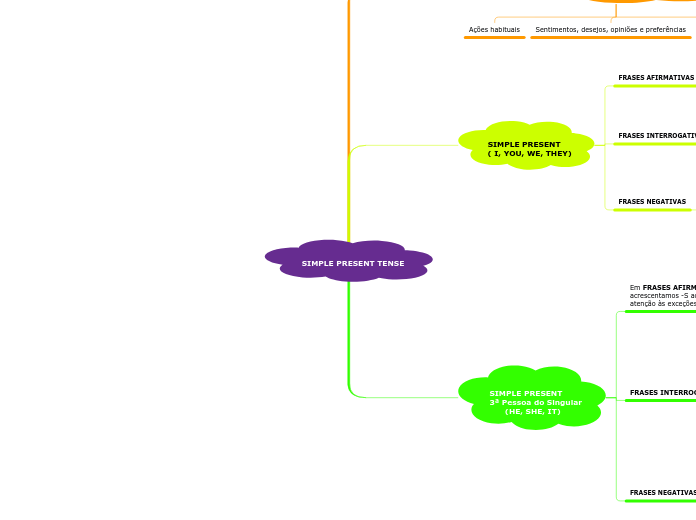SIMPLE PRESENT TENSE
QUANDO USAR O SIMPLE PRESENT
Ações habituais
Sentimentos, desejos, opiniões e preferências
Verdades Universais
SIMPLE PRESENT
( I, YOU, WE, THEY)
FRASES AFIRMATIVAS
Para conjugar um verbo no Simple Present, basta usá-lo no infinitivo, ou seja, sem o TO.
SUJEITO (PESSOA) + VERBO PRINCIPAL NO INFINITIVO (SEM TO) + COMPLEMENTO
FRASES INTERROGATIVAS
A forma interrogativa do Simple Present é formada com o uso do verbo auxiliar DO no início das sentenças.
VERBO AUXILIAR (DO) + SUJEITO (PESSOA) + VERBO PRINCIPAL + COMPLEMENTO
FRASES NEGATIVAS
A forma negativa é formada com o uso do verbo auxiliar DO e da negativa NOT. Pode ser utilizado na forma completa (DO NOT) ou na forma compacta (DON'T).
SUJEITO (PESSOA) + VERBO AUXILIAR + NOT + VERBO PRINCIPAL + COMPLEMENTO
SIMPLE PRESENT
3ª Pessoa do Singular
(HE, SHE, IT)
Em FRASES AFIRMATIVAS acrescentamos -S ao final dos verbos, atenção às exceções:
Verbos terminados em: -SS, -SH, -CH, -X, -O, -Z Acrescentar -ES
Verbos terminados em -Y precedido de vogal:
Acrescentar -S
Verbos terminados em -Y precedido de consoante:
Retirar o -Y e acrescentar -IES
FRASES INTERROGATIVAS
A forma interrogativa é formada pelo verbo auxiliar DOES, que é colocado no início das sentenças.
VERBO AUXILIAR (DOES) + SUJEITO + VERBO PRINCIPAL (SEM -S) + COMPLEMENTO
Ao utilizar a forma interrogativa os verbos ficam no infinitivo, sem o acréscimo do -S.
FRASES NEGATIVAS
A forma negativa é formada com o uso do verbo auxiliar DOES e da negativa NOT. Pode ser utilizado na forma completa (DOES NOT) ou na forma compacta (DOESN'T).
SUJEITO (PESSOA) + VERBO AUXILIAR + NOT + VERBO PRINCIPAL + COMPLEMENTO
Ao utilizar a forma negativa os verbos ficarão no infinitivo, sem o acréscimo do -S
